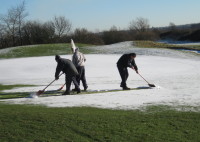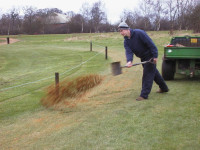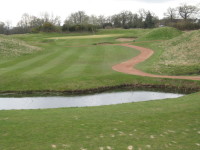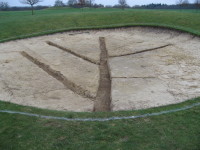January Golf Diary
 Fundamentals
Fundamentals
As a new decade begins, perhaps the most important aspect is to take time to review the current maintenance programme and to ask yourself the question 'Are the basic fundamentals of turfgrass management being carried out'? If not, then these need to be included in any future work planning since they are key to producing good turf quality and to meet with customer expectations. All other aspects of maintaining the golf course will be in addition to carrying out the basic principles of Water Management, Plant Nutrition, Mowing and Environmental Management.
Overview
In recent years, January has often been wet and mild whereas, in the past, Course Managers could rely on cold and frosty conditions to prevail. This limited the scope for 'serious' golf somewhat and constant sub-zero temperatures helped to kill off bugs and keep turf disease at bay. However, a few mild and very wet Januarys, such as experienced in 2007, have placed additional stress on the turf and playing conditions.
This is also the time of year when 'other' work such as tree trimming and scrub clearance can be completed. Light levels remain low in January and it is only towards the end of the month that the hours of daylight become a little more beneficial and afternoon golf is again possible.
Greens
With UK temperatures in January at their lowest and at an average of only 3 Celsius, virtually all plant growth will be dormant. The main emphasis will be to provide playing surfaces of suitable quality that are firm, dry and as smooth as possible. These criteria will largely centre on drainage, soil type, grass type and environment. Greens with poor surface or sub-surface drainage and high levels of organic matter will not provide these 'ideal' conditions.
Therefore, long term objectives must be to create a better growing environment. The question of frost and temporary greens is likely to be a 'hot' topic if frosty conditions prevail. Apart from managing the greens in a sustainable manner, the question is whether or not to allow the greens to remain in play or to protect the surfaces and use temporary greens.
For more detailed information and recommendations, refer to the article 'Winter Play Revisited' which appeared in March 2009. Two key recommendations mentioned were to utilise a two hole system whereby one such position would be close to the front edge of the green and this to be used during periods of hard frost.
The idea being to allow play on the main green, thus maximising revenue but to limit any potential damage to a small peripheral area of the green. The other recommendation during frost is to instigate a one club length rule from the hole, whereby any ball inside this diameter becomes a 'gimme'. This has the advantage of avoiding holing out, thus reducing wear. It also helps in speeding up play and introducing an element of fun during adverse playing conditions.
Disease risk from Fusarium will probably still remain high in January unless sub-zero temperatures are the norm. This will keep Fusarium at bay but it will not eradicate it. Mowing should continue each week when conditions allow but more as a requirement to roll and clean the surface with the height of cut at 5mm or higher. Aeration should remain as a key priority in order to allow as much air as possible into the rootzone, but only when ground conditions are favourable.
Following up with a light sand dressing afterwards will help to 'firm-up and settle' the surface, but avoid smothering the grass. Fertiliser requirement will be low but, if sandier rootzones are showing signs of 'leached' nutrient loss, then a very small amount of Nitrogen can be applied along with a higher amount of Potassium. The addition of sulphate of Iron or one of the many chelated products on the market will give enhanced colour but, if the intention is for disease control, then only the former will prove effective. Continuing to keep surfaces dry remains the key objective, therefore brushing and switching must feature on a daily basis.
Tees
 Maintenance requirements this month are largely a continuation from those in December. Whatever grass tees are in use, the requirements remain the same, namely clean, dry and firm surfaces. Therefore, regular brushing, periodic tining and light sanding will be the norm along with varying degrees of traffic control, especially on raised tees.
Maintenance requirements this month are largely a continuation from those in December. Whatever grass tees are in use, the requirements remain the same, namely clean, dry and firm surfaces. Therefore, regular brushing, periodic tining and light sanding will be the norm along with varying degrees of traffic control, especially on raised tees.
Here, there is a tendency for bankings to become worn if there are no designated access points. Where worm control was completed in late Autumn, there is a possibility that a repeat application will be necessary since the effectiveness of Carbendazim is limited to a maximum of 3 months. A periodic trim with the mower will help to clean and present the surfaces, but best to keep the height of cut above 12mm. Should the turf be lacking in colour, vigour and ability to recover from wear, then a low amount of Nitrogen can be applied to help replace any loss from leaching.
Surrounds
Traffic control measures, sand dressing and possible worm control will be the main requirements this month in order to maintain adequate turf cover and to provide good playing conditions. Similar to tees, aerify when ground conditions are suitable, penetrating as deep as possible to alleviate any compaction. Ensure that any outstanding turf repairs are completed this month in order to give the turf time to 'settle' prior to Spring. It is unlikely that any additional feed will be required at this time of year but there are always exceptions. If required, then feed as per tees.
Fairways
 This can be a key month for deep tine aeration if ground conditions are favourable. Operating a deep tiner with varying degrees of 'heave' will prove beneficial for removing surface water and to maximise air movement through the soil. Slitting is also beneficial and much quicker, but really needs to be completed a few times over the winter to make any real difference. As stated previously the use of a rotary decompactor may prove effective to remove water from areas between drainage laterals or into suitable outlets.
This can be a key month for deep tine aeration if ground conditions are favourable. Operating a deep tiner with varying degrees of 'heave' will prove beneficial for removing surface water and to maximise air movement through the soil. Slitting is also beneficial and much quicker, but really needs to be completed a few times over the winter to make any real difference. As stated previously the use of a rotary decompactor may prove effective to remove water from areas between drainage laterals or into suitable outlets.
If mild weather prevails then a periodic pass with a mower will help to tidy and define the surface, but avoid removing any real amount of grass cover. A useful ploy is to give the fairways a foliar application of Iron and Urea to give the turf a 'green-up' tonic. This is more of a cosmetic approach but does enhance presentation at a time when courses often take on a 'bleached' appearance. For less than £200 it can be money well spent at times when many clubs are looking for that competitive edge.
Bunkers
 Winter playability and consistency will remain the two key requirements, therefore good drainage is fundamental. Much time may be required in this area if the bunkers tend to hold water and suffer from wash-outs or erosion. Refer to the December article on renovation work which should be nearing completion by the end of this month. On a more routine basis, the requirements are to maintain adequate depth and sand on the faces along with regular brushing of sand from the surrounding banks.
Winter playability and consistency will remain the two key requirements, therefore good drainage is fundamental. Much time may be required in this area if the bunkers tend to hold water and suffer from wash-outs or erosion. Refer to the December article on renovation work which should be nearing completion by the end of this month. On a more routine basis, the requirements are to maintain adequate depth and sand on the faces along with regular brushing of sand from the surrounding banks.
Other
Lakes/Ponds/Ditches: January can be a good month for clearing the sides of ditches and to trim back any overhanging branches or to remove unwanted scrub vegetation such as alders. These have a tendency to restrict the flow of water. All ditch crossings should be checked and surfaces maintained in a safe and appropriate manner.
Paths: A continuation of previous month's work, whereby paths should be kept free of pot-holes and any standing water. Small drains may need to be cut to alleviate such problems and path ends should be regularly sanded where necessary. Additional traffic control measures may also be required to divert traffic away from main or wet lying areas. Alternative routes during winter are good practice and help to protect the main play areas during the 'off-season'.
Trees:
As mentioned last month, tree trimming, branch removal and scrub clearance should be a key part of winter maintenance, and especially when weather conditions limit main course work. This is carried out for a number of reasons such as reduced ball searches, improved air flow or general woodland management. Whatever the reason, such work should form part of the larger environmental plan for the course and not just limited to areas of woodland. Hedgerows, wetlands, gorse and grassland will all come under this 'environmental umbrella' and the dead of winter is an ideal time to make inroads into this area of work.
Renovation Projects: This is likely to be an on-going programme of work with likely projects being drainage, ditch work, bunker renovation, tee levelling/extensions and path work. With work likely to be halted when ground conditions become unsuitable, it is important to have contingencies in place since January weather can be unpredictable. A hard frost can be an advantage for some work e.g. movement of materials and base building, whereas it can be a hindrance for any planned turfing. If alternatives can be provided to suit conditions then both angles can be covered. For most golf courses, tee extensions and bunker renovations will be an annual requirement and form part of a cap-ex rolling plan of improvements.
Watchlist:
Disease: During January, disease pressure from Fusarium could remain high if wet and mild conditions prevail. In 2007, disease pressure was fairly intense as day time temperatures increased to over 10° Celsius for several days. Enough has been mentioned in previous monthly articles on disease control, the fungicides available and their modes of action, but it is the 'basics' that need to be in place as part of the IPM strategy. Should there be a freezing and thawing scenario after a fall of snow, then snow mold could be a problem, albeit relatively rare for most of the UK. Unfortunately, there is little to control after the event, therefore the best plan of action is to improve turf conditions and to keep a very watchful eye on weather forecasting. The application of a preventative fungicide in advance of lengthy snow cover is a viable option, but obviously more difficult to predict. It all comes down to the element of risk versus the cost involved.
Pests: Only earthworms are likely to be a nuisance to managed turf during January therefore control from Carbendazim will be required. This is more than likely to be second application at this stage of the season. See previous articles for more information.
Turf Disorders: As per last month, both Algae and Black Layer will continue to be the most likely turf disorders at this time of year, and both have been mentioned in detail in previous articles. Moss may also be quite prevalent at this time of year due to lack of turf vigour and low levels of light intensity. For many areas it is just a slight winter 'nuisance' and soon disappears when spring returns. If more persistent, then moss control will be necessary but January is not the time for such work other than to carry out routine practices of aerification and, perhaps, a little use of sulphate of Iron.
Equipment:
By the end of this month, servicing, repair and overhaul of equipment should now be over half complete. During January and February, only a few mowing machines will be in use and only for periodic use, therefore it is during the latter stages of the winter that the emphasis will switch to these machines.
Sharpening of reels and replacement of bottom blades are a key requirement, therefore it is important that all such replacement parts are in stock and readily available. As well as servicing of equipment, each machine should receive a deep clean and this is a good job for a wet day when other work is less desirable.
Various cleaning products are on the market that can make a positive impact on metal, vinyl and rubber. A gleaming, well maintained item of equipment sends out a clear and professional message of good management as well as giving a sense of pride to the staff who will be operating these machines. When equipment is properly maintained, clubs are more likely to be sympathetic when it comes to the time to replace or add an additional item of equipment. See previous article on machinery replacement schedules.
Compound:
The start of the year is also a good time to operate the 'new broom' strategy with the aim of starting afresh. This means a thorough clean-up and re-organisation of all internal and external areas of buildings and compound. Staff room, toilet and wash areas will probably require a deep clean, then a re-paint and days when the weather is poor are ideal for such work. With a few staff at hand, this work can be completed quickly and, once again, gives a sense of pride and achievement of a job well done.
Laurence Pithie MG
Turf Master One Ltd
www.turfmasterone.co.uk
